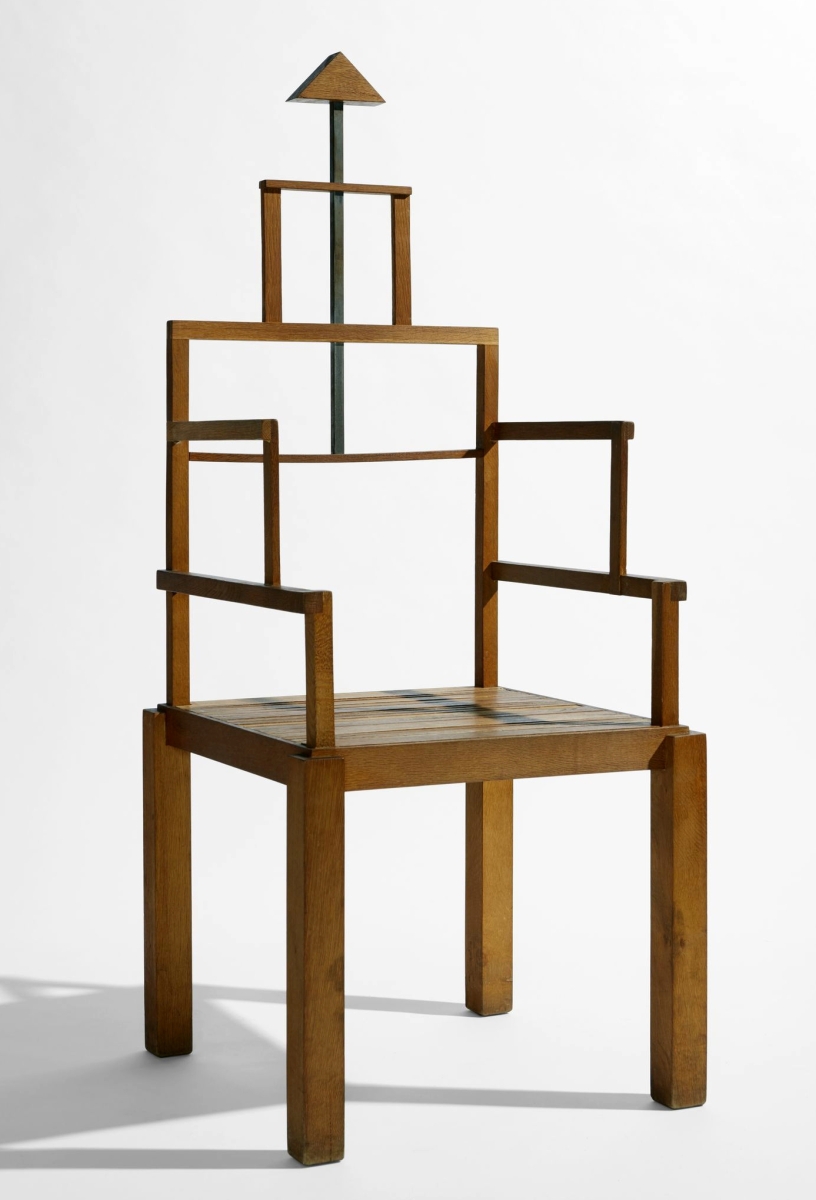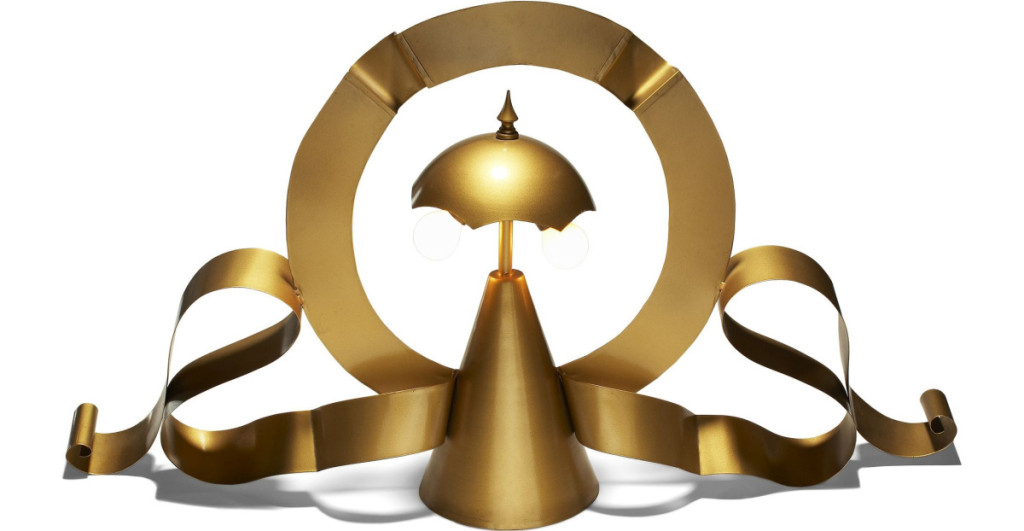
“MGM” table lamp by Lapo Binazzi, UFO, designed 1969, made circa 1975. Aluminum, enamel and bulb. The Museum of Fine Arts, Houston, the Dennis Freedman Collection, Museum purchase funded by the Caroline Wiess Law Accessions Endowment Fund. ©1969 Lapo Binazzi (UFO). Photo by Brad Bridgers.
By Greg Smith
HOUSTON – Like many others, I was introduced to the Italian Radicals through the movement’s prodigal, commercially driven successor, the Memphis Group. I will always remember the first time I encountered an example of Memphis design, thumbing through an old auction catalog in my nascent days as I jostled back and forth on a Metro North train en route to an internship. I took those catalogs everywhere, trying to learn the forms. I remember turning the page – my gaze narrowing and teeth grinding – overcome with emotional disgust at the sight of a Peter Shire chair. How much it reminded me of the 1980s, as if it were salvaged from the set of Saved by the Bell. I was incredulous at the prices. “Don’t people have taste?” I thought.
Although I committed a considerable amount of time to those catalogs, I can say with honesty that I do not remember a single other impression from those days like I remember that Shire chair. The memory remains so lucid because of its ability to draw a very real emotional response. I proclaimed nonsense: from the colors to the juxtaposed geometric shapes to the very fact that many of these things seemed – in the most basic sense – unpalatable. I very much hated that chair, but at the same time, I demanded answers.
This was intentional, you see. I had sprung the trap. The design was challenging me – and I was provoked.
In his catalog essay, writer Germano Celant, who is credited with coining the term “Radical” in an earlier 1972 essay, reflects, “There was a need for openness in design and consumption, for perspectives that were not determined by the market, but contrary to it, and nourished by at least the ‘appearance’ of provocation and scandal.”
At some point thereafter, the when unknown, I came to adore that chair, and most other designs that came into being from this talented, young group of idealists and reformists.
Italian Radical design is one of the most original design aesthetics of the Twentieth Century. Perusing the current seasonal retail design catalogs, I sometimes find myself reenacting Jake Gyllenhaal’s art critic character Morf Vandewalt in Velvet Buzzsaw, looking at some new set of legs, unable to suppress the word “derivative” as I offer my unsolicited condolences to the designer who dreamt it up first, wondering if the royalties have been properly channeled. There is no need to do that with this group of Italians – these architects and designers embarked on a world of pure imagination unlike any before them.
“Radical: Italian Design 1965-1985,” a new exhibition curated by Cindi Strauss at the Museum of Fine Arts, Houston, shines a scholarly light on this movement in a manner not seen in the United States since the 1972 exhibition at the Museum of Modern Art titled “Italy: The New Domestic Landscape.” Strauss’ exhibition pulls together 70 pieces of furniture, lighting design, architectural models, paintings and objects from the collection of Dennis Freedman.
Prior to 2010, Freedman was the creative director of W magazine, when he left to occupy the same title at Barneys New York. He now spends his time consulting for design galleries and fashion brands.
“Dennis’ collection of Italian Radical design is one of the finest and most comprehensive in the U.S.,” Strauss said. “He really sought to represent all of the major themes and players in that movement. He searched for prototypes and conceptual objects in addition to those that were perhaps more widely known. As a collector, he has left no stone unturned and his passion and enthusiasm for the material, combined with the deep knowledge he has developed over a few decades of collecting, has resulted in an extraordinary body of work.”
The exhibition’s accompanying catalog is notable in that it provides testimony. Strauss conducted interviews with some of the key figures of the movement, including Franco and Nanà Audrito, Lapo Binazzi, Andrea Branzi, Alessandro Guerriero, Ugo La Pietra, Alessandro Mendini and Franco Raggi, excerpts of which are found within the text. The aforementioned essay by Germano Celant is a must-read. Strauss also conducts a Q&A with Freedman at the outset of the catalog where he describes his collecting journey, which began in 1998 with a Studio65 Capitello chair. That journey continued on through small galleries and international auction houses to the present day.
In the mid-1960s, Italy is undergoing a rapid expansion in industry and consumerism. The effects of World War II are beginning to shake off, production is increasing and students are flocking to schools where, surprisingly, architecture becomes the country’s most popular university major. Steeped and surrounded by historic, traditional architecture, students are taught reverently of the International Style and the progress that had been at hand for the past few decades, though labeling it as progress turned out controversial.
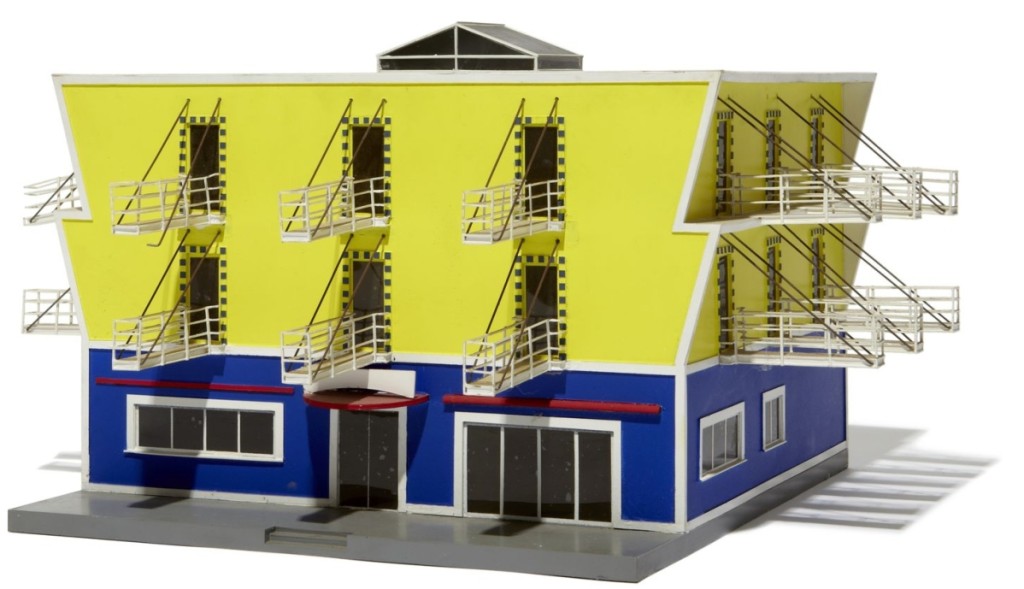
“Pensione Atlantic” summer architectural model by Franco Raggi, 1981. Plastic, paper and steel. The Museum of Fine Arts, Houston, the Dennis Freedman Collection, gift of Dennis Freedman. ©1981 Franco Raggi. Photo by Kent Pell.
“This is a group of young architects who are challenging long-held ideas about design in response to the changing nature of cities during their era,” Strauss says. “They are very focused on objects as communication devices – as ideas – and they are interested in what’s happening around them in other disciplines, like painting and sculpture, and bringing in new materials to investigate what’s possible. There is everything from deep meaning to humor, irony and problem-solving in these works. Across the board, the pieces are very thoughtful in their concept of design, their questioning of functionality, their challenging of the viewer to make sense of them.”
In short, the students had issues with the status-quo and their protests spread to universities throughout the country.
Rejection of modernism and established hierarchies ensued as the young Radicals dedicated themselves to “developing a new language of expression…and rethinking environments for living.” Strauss notes that nearly every Radical architect or designer cites the first exhibition of American Pop Art in Italy at the 1964 Venice Biennale as a watershed moment. The designers would also find inspiration in aspects of Arte Povera, Minimalism and Conceptual Art.
“Surprisingly to many,” Strauss writes, “their plans did not involve the traditional building of structures. Rather, their projects most often took the form of drawings and photomontages, theoretical environments and object designs.” While furniture, lighting and object designs from this nascent period exist, and are indeed the visual candy of the MFAH’s exhibition, it is important to correctly characterize the movement’s output: the focus here was in theoretical conversations and non-material products. It is first and foremost an incubator of architecture and the ideas for a new way of living.
Architect, artist and critic Gianni Pettena explains how the tangential practice of design tied it all together when he said, “design’s smaller scale was a daily exercise to practice the language of architecture.”
Creating a captivating exhibition of concepts on paper might be considered radical in itself, so Strauss instead worked through the movement with objects as they demonstrated regionalism between various collectives of architects and designers, new materials employed by visionary manufacturers, and the development of this new language.
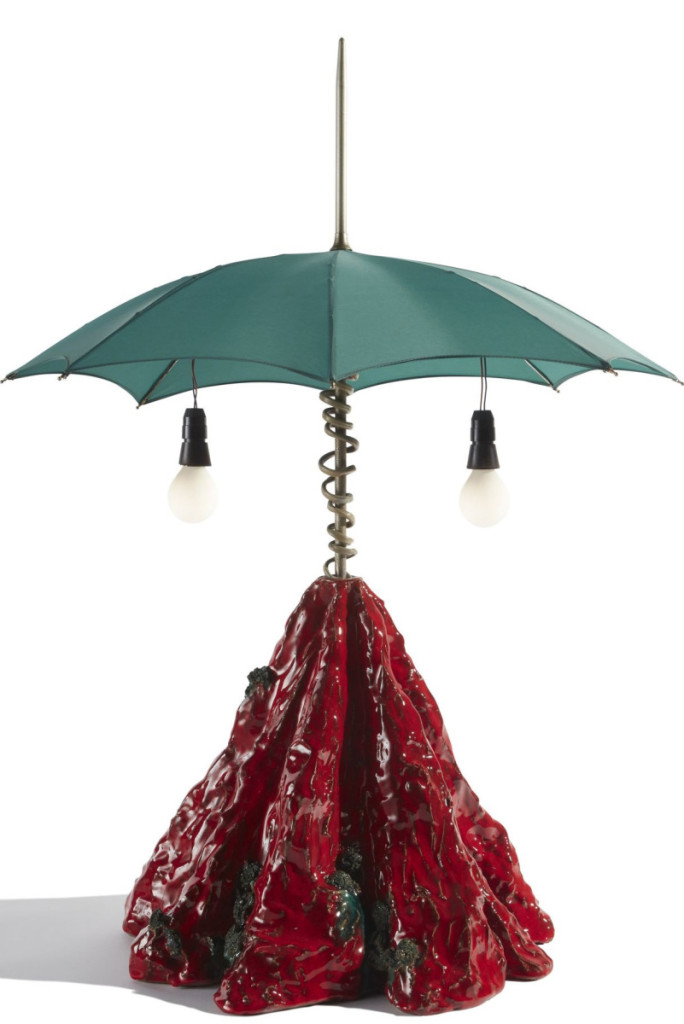
“Paramount” table lamp, designed by Lapo Binazzi, UFO, designed 1969, made circa 1972-73. Ceramic, silk, metal and bulbs. The Museum of Fine Arts, Houston, the Dennis Freedman Collection, Museum purchase funded by the Caroline Wiess Law Accessions Endowment Fund. ©1969 Lapo Binazzi (UFO). Photo by Kent Pell.
The Radical movement found followers throughout Italy, but it was in its main cities of Florence, Milan and Turin that organization was cemented.
In Florence, Radical collectives bloomed from the Architecture Students League at the University of Florence, birthing Archizoom, Superstudio, Gruppo 9999, UFO and Zziggurat.
Collectives and the conversations occurring therein were paramount to the development of Radical design. The catalog quotes Branzi, a member of Archizoom, saying, “We had the idea of a homogenous group, in which what held us together was not specialization, but rather participation in a vision of architecture that was adequate for pop culture’s consumerism.”
Like Detroit’s relationship with Ford, Fiat was the industrial center of Turin, where people became concerned with worker’s rights and standards of living. It was here that Franco Audrito founded the collective Studio65 while another, Gruppo Strum, became embroiled in the political debate.
Milan turned into the center of communications with the home offices of visual and performing arts publications Casabella, Domus, Modo and In, edited mainly by Mendini, Raggi and La Pietra.
In his first letters to readers in Casabella, Mendini wrote, “we think that the work of a review must be aimed at the service for man, a humble service, which now seeks to defend itself, without much success, against designer-style, designer-records, the designer-mafia, the designer profession à outrance, and the design-academy, in favour of the man who intends to re-emerge as the subject – not as the object – in every phase of the battle over the form of the environment.”
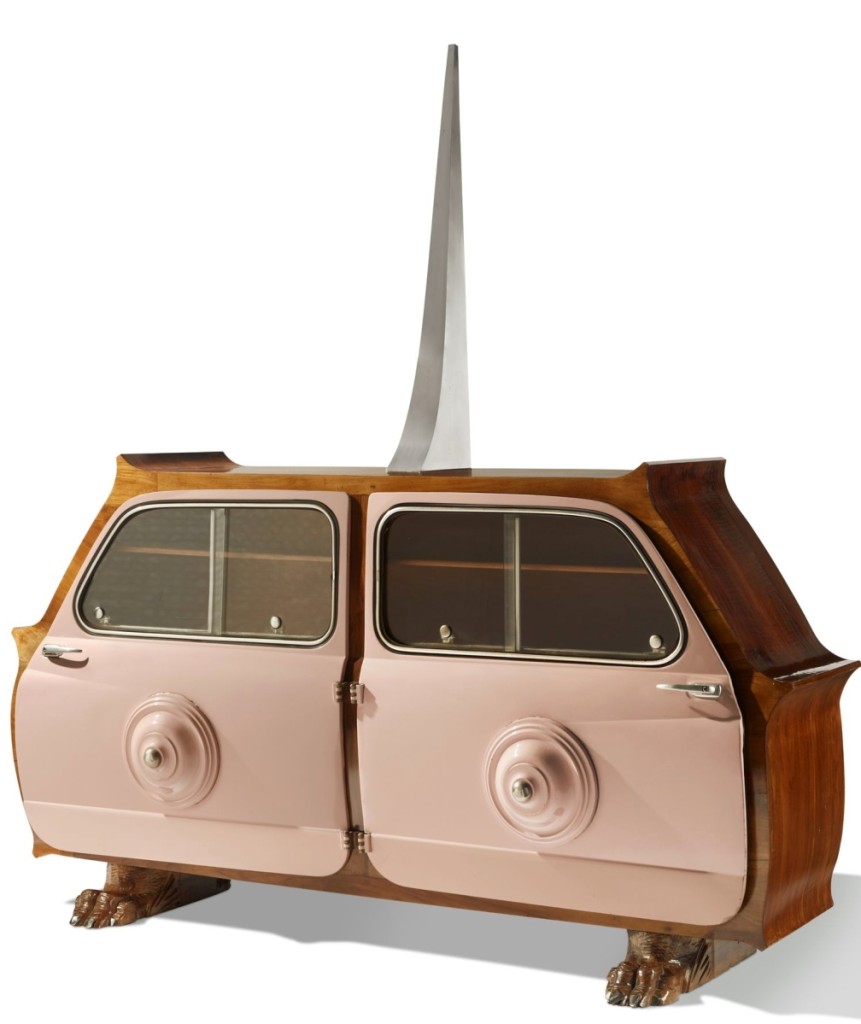
“Cielo, Mare, Terra Buffet” by Fabio De Sanctis and Ugo Sterpini, Officina Undici, 1964. Walnut, metal, and two Fiat doors of the 600 prima series. The Museum of Fine Arts, Houston, the Dennis Freedman Collection. Museum purchase funded by the Caroline Wiess Law Accessions Endowment Fund. Photo by Kent Pell.
A succession of exhibitions platformed the course of this movement, starting in the aforementioned 1964 Venice Biennale where Italy was introduced to Pop Art. The following year, Milan’s Salone del Mobile would begin to showcase works from these designers and architects. In 1966, Galleria Jolly 2 in Pistoia organized the “Superarchitettura” exhibition, the first dedicated demonstration of the movement, which brought together designs by collectives Archizoom and Superstudio. “The show was a marvel,” Strauss writes, “with brightly colored scenic designs on the basement walls and ceilings and ‘a series of violently colored objects that could be used as lamps, armchairs, and sofas…'”
In walks Sergio Cammilli, who established the design manufacturer Poltronova. Cammilli would go on to produce items in that exhibition including the “Superonda” and “Sofo” seating as well as the “Passiflora Lamp.”
Other Italian manufacturers that picked up the movement’s designs at various times included most notably Gufram, and also Zanotta, Gavina, Cassina, C&B Italia, Artemide, Stilnovo, Forme e Superfici, New Lamp Italia, Solka B and Sormani.
“One of the things that’s important to understand is that it wasn’t an exhibition like we think of today,” Strauss said. “It was a total environment, so you saw architectural elements on the wall, you did have some furniture that was made, but it was mostly conceptual. There was a design for the ‘Passiflora Lamp’ that we have included in our show – they weren’t able to realize it as a lamp so it was a painted cardboard cutout in the exhibition at that time.”
The exhibition was small by all standards, and a change of venue saw it relocated out of Florence due to massive flooding in the month prior. It went unseen by most, and those who did see it were people involved in the circle of the Radicals. Otherwise, it didn’t make headlines.
In fact, contemporary reception to the Radicals was nil. “There was no reception,” Strauss said. “This is very avant-garde design. They were published in art and design magazines that didn’t have big readership. There wasn’t this huge kind of reception that we think about today. There were some exhibition opportunities abroad in Germany, France, London and the United States, but we can’t measure the kind of success it had in the way we would measure it today, through sales and things of that nature.”
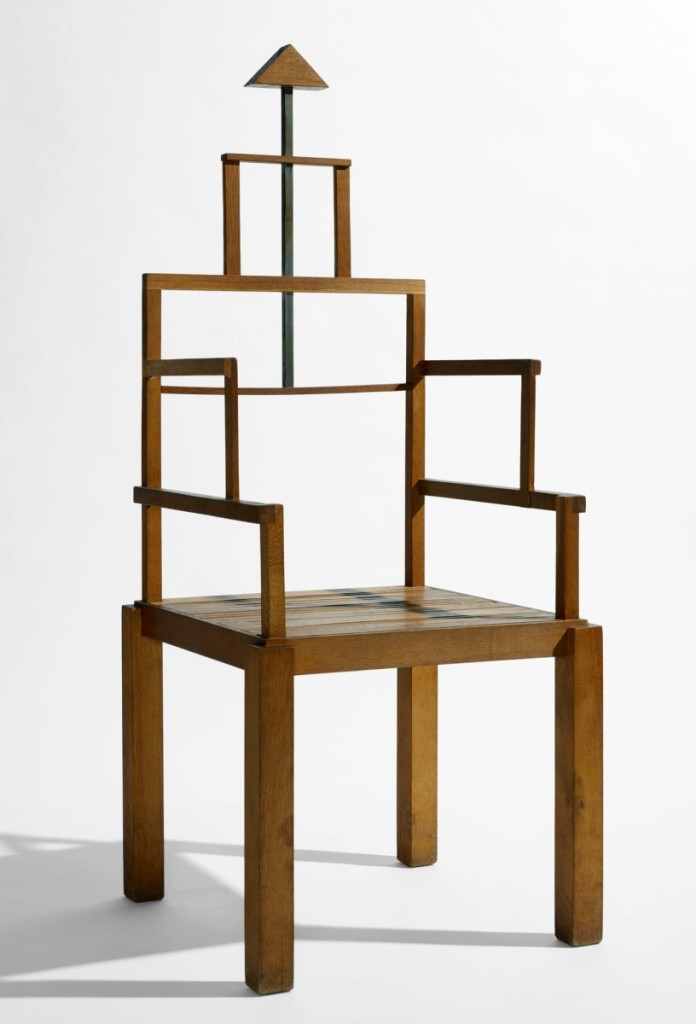
“San Picasso” Chair by Ugo Marano, 1978. Wood. The Museum of Fine Arts, Houston, the Dennis Freedman Collection, Museum purchase funded by the Caroline Wiess Law Accessions Endowment Fund. Photo by Kent Pell.
Strauss related that the experience of going through Freedman’s collection provided her multiple instances of seeing designs for the first time. “The Ricardo Dalisi wood chair stopped me in my tracks, a lot of his work was more ephemeral, and I had seen images, but since most of them were one-offs, I had never seen one of Dalisi’s designs in person until I met Dennis,” she said.
The exhibition provides a wealth of similar examples. “There’s an armchair and table by Urano Palma from his ‘Diapositive’ series and the ‘San Picasso Chair’ by Ugo Marano – those are one-offs. There are prototypes, too, like the 1969 ‘Prototype Table and Chair, Model Nos 230/1/2/’ by Fabio Lenci. There are objects where only a handful were made, like the ‘Archangeli Metropolitani Floor Lamp’ by Ugo La Pietra or the Fabio De Sanctis and Ugo Sterpini ‘Cielo, Mare, Terra Buffet’ cabinet. There are two Mendini chairs in the show, one is one of four and the other is one of six. Even with the pieces that were put into production, they were not made in large numbers and they were not necessarily commercially successful. But that was not the designer’s goal, to create commercially successful wares.”
A major feat for the movement came in 1972 when the Museum of Modern Art launched the exhibition “Italy: The New Domestic Landscape.” The exhibition was split between “objects” and “environments,” with the Radicals largely participating in the latter.
When the show came to an end, the collectives found themselves in a precarious position: they had reached the masses, their ideas, even if not adoptable, went mainstream. Strauss writes, “[the] mounting of an exhibition at an established institution such as the MoMA was, for many, a sign that the Radical period had ended. Indeed there is great debate as to when the movement ended or whether it ever existed at all.”
The period that followed, from the 1970s into the 1980s, sprouted two new commercial collectives that focused on design output, working to produce the body of work that consumers are familiar with today – those of Studio Alchimia and the Memphis Group.
Alchimia was founded by Alessandro and Adriana Guerriero and Bruno and Giorgio Gregori, and worked with Binazzi, Branzi, Trix and Robert Haussmann, Michele De Lucchi, Mendini, Paola Navone and Ettore Sottsass. Major designs came out of this collective, including Mendini’s “Proust” armchair.
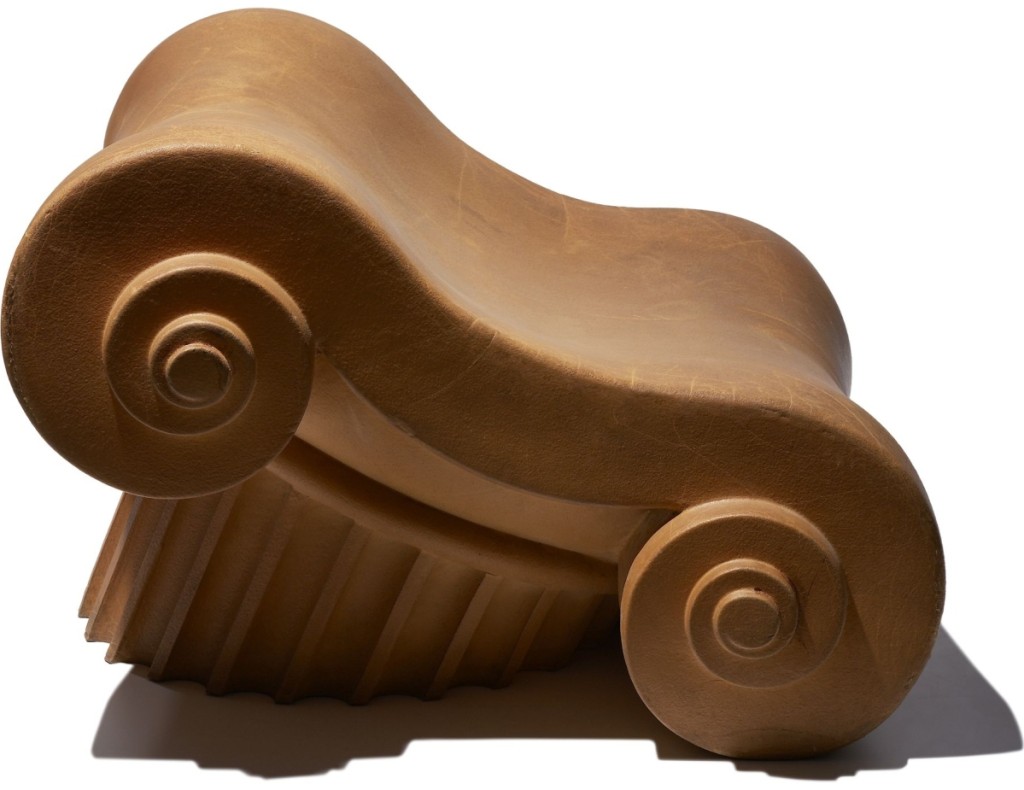
“Capitello” designed by Studio65, manufactured by Gufram©, design 1971, made circa 1972-78. Polyurethane foam and Guflac®. The Museum of Fine Arts, Houston, the Dennis Freedman Collection, gift of Dennis Freedman. ©1971 Studio65. Photo by Brad Bridgers.
Sottsass split with the group in 1980 and would form Memphis the following year. His collaborators spanned even further internationally, to include Branzi, Michael Graves, Arata Isozaki, De Lucchi, Nathalie Du Pasquier and George Sowden. Sottsass said, “It’s an optimistic approach. After all the years of discussion, we started thinking we could rebuild something all over again, using industrial materials as much as possible and handcrafts as little as possible. There are no quotations from the past in these works.”
That same year, in 1981, 17 years since first exhibiting the work of Italy’s Radicals, Salone del Mobile presented a series of work by Memphis that launched the brand into contemporary acclaim.
Revisiting the movement in the exhibition catalog’s essay, Germano Celant writes, “Imaginative design became the focus of attention, and as objects escaped the functional annihilation of reductivist imagery, designs began to take on decidedly spectacular aesthetics. Colors and materials exploded optically and tactilely. Practical concerns were abandoned in favor of an extravagant, whimsical creativity unconcerned with harmony and function.”
Expect to be surprised.
“It’s really hard to see this material in America, most American museums don’t collect it. American audiences really are not familiar with this important design movement, and that’s what we hope this show will do,” Strauss said.
The exhibition runs February 14 through April 26 and will travel to the Yale School of Architecture in fall 2021. The accompanying 234-page full-color catalog is published by Yale University Press and is available at www.yalebooks.yale.edu. The Museum of Fine Arts Houston is at 1001 Bissonnet Street. For more information, www.mfah.org or 713-639-7300.

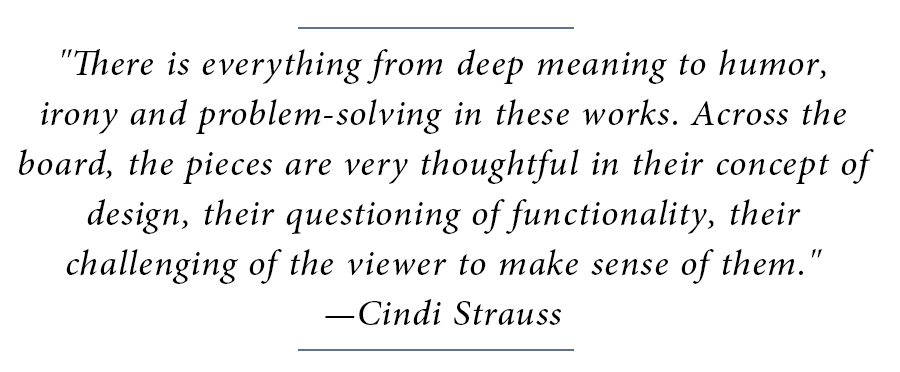



.jpg)






